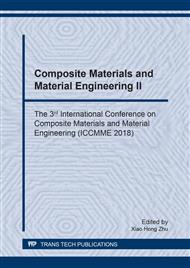p.38
p.45
p.51
p.56
p.62
p.71
p.77
p.83
p.89
Porous Properties of Carbon/Carbon Composite Xerogels
Abstract:
Carbon/carbon composite xerogels are prepared by a vacuum drying technique whereas a carbon cryogel is synthesized by a freeze drying technique to compare the effect of these drying methods at the selective synthesis condition. Resorcinol and formaldehyde are used to prepare a matrix phase and cotton fibers are acted as a disperse phase of the carbon/carbon composite xerogels. Here resorcinol and formaldehyde is utilized to synthesize the carbon cryogel only. The carbon/carbon composite xerogels and the carbon cryogel were analyzed by a nitrogen adsorption apparatus and a field emission scanning electron microscope. The results support that the vacuum drying can decrease the pore shrinkage despite of the gas-liquid interface. The porous properties of the carbon xerogel is quite equivalent to the porous properties of the carbon cryogel. When the porous properties of carbon xerogels are considered, their porous properties can be preserved at the high porosity until 0.15 g/g of the cotton fibers/resorcinol ratio. At 0.25 g/g of this ratio, the porous properties start decreasingly.
Info:
Periodical:
Pages:
62-67
Citation:
Online since:
August 2018
Authors:
Price:
Сopyright:
© 2018 Trans Tech Publications Ltd. All Rights Reserved
Share:
Citation:


